
The first ever Safety Car period in Formula 1 came at the 1973 Canadian Grand Prix. Since then, there have been 36 Safety Car deployments at Circuit Gilles Villeneuve, including five VSC periods. Here’s a list of every Safety Car deployment at the Canadian Grand Prix!
1973 Canadian Grand Prix, Lap 35
Francois Cevert and Jody Scheckter collided in the 1973 Canadian Grand Prix, held at Mosport Park. Their collision brought out the first Safety Car in Formula 1 history. The caution period was somewhat of a shambles, however. The Safety Car – a yellow Porsche 914, driven by Eppie Wietzes – picked up the wrong driver – allowing some cars, including eventual race winner Peter Revson, to gain a lap on the rest of the field.
1997 Canadian Grand Prix, Lap 7
Ukyo Katayama crashed on Lap 5 of the 1997 Canadian Grand Prix. The Safety Car was called out two lap later to enable marshals to remove his car. Oliver Gavin drove the Safety Car at this event – its first appearance at Circuit Gilles Villeneuve.
1997 Canadian Grand Prix, Lap 53
A huge crash for Olivier Panis left a tyre barrier strewn across the track at the exit of Turn 4. The Frenchman broke his legs in the incident. The race was stopped under Safety Car conditions and was not restarted.
1998 Canadian Grand Prix, Lap 1
After a red-flagged first start, the second start of the 1998 Canadian Grand Prix also saw carnage, with five cars retiring. The incident was started by Ralf Schumacher, who went across the grass and spun through Turn 1. Jean Alesi’s car ended up mounted on top of Jarno Trulli’s car.
1998 Canadian Grand Prix, Lap 15
An off-track excursion for Pedro Diniz deposited dirt and grass all over the circuit, leading to another Safety Car call out in the 1998 Canadian Grand Prix.
1998 Canadian Grand Prix, Lap 20
For the first time, the Safety Car made three appearances in a single Grand Prix. This one was caused by Mika Salo colliding with Johnny Herbert.
1999 Canadian Grand Prix, Lap 1
Jarno Trulli spun at Turn 1 on the opening lap of the 1999 Canadian Grand Prix and collected Jean Alesi, eliminating both drivers from the race.
1999 Canadian Grand Prix, Lap 4
The 1999 Canadian Grand Prix was the race in which the ‘Wall of Champions’ picked up its name. Ricardo Zonta was first to hit the wall during the Grand Prix, retiring from the race.
1999 Canadian Grand Prix, Lap 37
Jacques Villeneuve was the next victim of the Wall of Champions, bringing out the Safety Car for the third time in the 1999 Canadian Grand Prix.
1999 Canadian Grand Prix, Lap 67
For the first time four Safety Cars were called out in a single race. The final one of the 1999 Canadian Grand Prix was caused by a crash for Heinz-Harald Frentzen. This was the first Formula 1 race to finish under Safety Car conditions.
2001 Canadian Grand Prix, Lap 21
Rubens Barrichello and Juan Pablo Montoya retired on Lap 21 of the 2001 Canadian Grand Prix. Montoya hit the wall, eliminating himself from the race, while Barrichello swerved trying to avoid the Williams – hitting the opposite wall as a result. Marcel Fässler was the Safety Car driver at this event due to regular Safety Car driver Bernd Mayländer being injured.
2002 Canadian Grand Prix, Lap 14
Jacques Villeneuve retired with an engine failure. The Safety Car was called while the BAR was cleared away. This was the first time that Bernd Maylander led the field at the Canadian Grand Prix.
2005 Canadian Grand Prix, Lap 47
Jenson Button became the Wall of Champions’ latest victim in the 2005 Canadian Grand Prix, crashing there at the end of Lap 46.
2006 Canadian Grand Prix, Lap 2
When defending from Juan Pablo Montoya, Nico Rosberg collided with the McLaren driver and speared into the barriers. The yellow flags were already out at this point, with the two Midland drivers having collided at the hairpin on the opening lap. Christijan Albers was out on the spot, while Tiago Monteiro pitted for a new front wing.
2006 Canadian Grand Prix, Lap 60
On his final home race appearance, Jacques Villeneuve got on the marbles and collided with the barriers bringing out the Safety Car.
2007 Canadian Grand Prix, Lap 23
Adrian Sutil hit the wall at Turn 4, his car coming to a stop just after. A Safety Car was called while his car was removed from the track.
2007 Canadian Grand Prix, Lap 28
Robert Kubica suffered a spectacular airborne crash at the hairpin after making contact with the rear of Giancarlo Fisichella’s Renault .
2007 Canadian Grand Prix, Lap 50
Debris from a crash involving Christijan Albers on the previous lap at Turns 8 & 9 brought out the Safety Car on Lap 50.
2007 Canadian Grand Prix, Lap 56
The Safety Car was deployed four times in the 2007 Canadian Grand Prix. The final caution period was due to Vitantonio Liuzzi colliding with the Wall Of Champions.
2008 Canadian Grand Prix, Lap 17
A gearbox failure for Adrian Sutil saw him stop at the side of the track near Turn 3 in the 2008 Canadian Grand Prix. The Safety Car was called out after his brakes caught fire.
2011 Canadian Grand Prix, Lap 1
The 2011 Canadian Grand Prix began under Safety Car conditions due to damp weather conditions. The first four laps of the race took place behind the Safety Car.
2011 Canadian Grand Prix, Lap 8
On the main straight, McLaren team-mates Lewis Hamilton and Jenson Button collided. Hamilton pulled up with broken suspension later around the circuit on Lap 8.
2011 Canadian Grand Prix, Lap 20
The Safety Car was called out due to deteriorating weather conditions. It remained out until the red flag was called on Lap 25.
2011 Canadian Grand Prix, Lap 25
After a lengthy red flag period, the 2011 Canadian Grand Prix restarted behind the Safety Car, which completed ten laps before returning to the pit lane. This is the longest Safety Car period to date at Circuit Gilles Villeneuve – and the longest in Canada since the first deployment in 1973.
2011 Canadian Grand Prix, Lap 37
Fernando Alonso beached his car after contact with Jenson Button on Lap 37 of the 2011 Canadian Grand Prix.
2011 Canadian Grand Prix, Lap 57
The sixth Safety Car call out of the 2011 Canadian Grand Prix came after Nick Heidfeld made contact with the rear of Kamui Kobayashi’s Sauber. He then ran over his own front wing and crashed off down an escape road. This Safety Car was notable for a marshal, who ran on track to clear debris, falling over and almost being run over as oncoming cars approached.
2014 Canadian Grand Prix, Lap 1
Marussia team-mates Max Chilton and Jules Bianchi collided on the opening lap of the 2014 Canadian Grand Prix at Turn 4.
2014 Canadian Grand Prix, Lap 70
At the start of the final lap of the 2014 Canadian Grand Prix, Felipe Massa and Sergio Perez collided leading to a high speed crash at Turn 1. The race finished behind the Safety Car.
2016 Canadian Grand Prix, Lap 11
Jenson Button stopped trackside on the back straight after reporting a loss of power. The rear of his car was on fire, but the McLaren was soon cleared away under VSC conditions. This was the first time the VSC appeared at the Canadian Grand Prix. The VSC period lasted just over a minute.
2017 Canadian Grand Prix, Lap 1
Carlos Sainz and Felipe Massa collided on the opening lap of the 2017 Canadian Grand Prix. Sainz was out of control after spinning on his way to the corner. Massa could not avoid the spinning Toro Rosso. Romain Grosjean was also caught up in the incident, requiring a new front wing.
2017 Canadian Grand Prix, Lap 11
Max Verstappen stopped, retiring from the race with an electrical failure. The subsequent VSC period also gave marshals chance to clear debris from the Lap 1 incident, plus a Ferrari cap under the bridge at Turn 8. This VSC period lasted around 5 minutes.
2018 Canadian Grand Prix, Lap 1
The 2018 Canadian Grand Prix featured an opening lap crash for Brendon Hartley, who rode the barriers and tangled with Lance Stroll. Ironically, the crash meant that Stroll did not reach the grandstand named after him at the hairpin.
2022 Canadian Grand Prix, Lap 9
Sergio Perez stopped with a mechanical failure between Turns 8 and 9. The VSC was deployed for just under three minutes.
2022 Canadian Grand Prix, Lap 20
Mick Schumacher stopped on track when running in seventh place. The VSC period lasted just under two minutes.
2022 Canadian Grand Prix, Lap 49
The Safety Car was called out on Lap 49 of the 2022 Canadian Grand Prix, when Yuki Tsunoda crashed at Turn 1 just after exiting the pit lane.
2023 Canadian Grand Prix, Lap 8
After being told to stop his car, Logan Sargeant brought about a brief Virtual Safety Car period on Lap 8 of the 2023 Canadian Grand Prix.
2023 Canadian Grand Prix, Lap 12
Four laps after the VSC, the full Safety Car was called due to a crash for George Russell. The Mercedes driver clattered the wall at the exit of Turn 9. Russell was able to carry on despite his crash but eventually retired on Lap 54. Racing action resumed on Lap 17. Notably, this Safety Car period made Bernd Maylander the oldest driver to ever ‘lead’ a Grand Prix, setting a new record 70 years to the day since the previous record was set.
2024 Canadian Grand Prix, Lap 25
In damp conditions, Logan Sargeant crashed into the wall on Lap 25 of the 2024 Canadian Grand Prix, leading to the deployment of the Safety Car. The Safety Car period lasted for five laps.
2024 Canadian Grand Prix, Lap 54
Just as the leaders had started Lap 54 of the 2024 Canadian Grand Prix, the Safety Car was called for the second time in the race following an incident involving Carlos Sainz and Alex Albon. Sainz spun in the slippery conditions, into the path of the Williams driver. Both drivers retired as a result, with the Safety Car period lasting five laps.
VSC board graphic: Pitlane02, Wikimedia Commons, CC BY-SA 3.0



